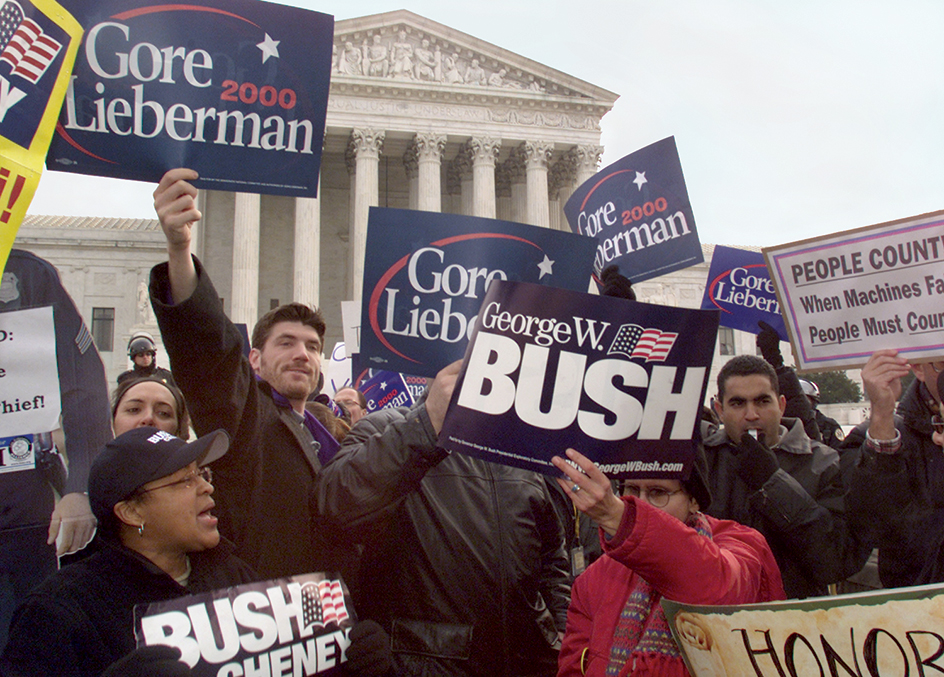United States presidential election of 2000 was one of the closest and most unusual presidential elections in United States history. The outcome—that Republican George W. Bush defeated his Democratic opponent Al Gore—remained in doubt for five weeks after the election. Bush received more electoral votes but fewer popular votes than Gore. A decision by the Supreme Court of the United States led to the final resolution of the contest (see Bush v. Gore ).

On Election Day,
November 7, over 100 million U.S. citizens went to the polls. The race was extremely close between Texas Governor Bush and Vice President Gore. In Florida, the race was particularly tight. It became obvious that the election depended on who got Florida’s 25 electoral votes (see Electoral College ).
Early in the evening, television newscasters predicted that Gore would win Florida. But official tallies from the state showed an increasing number of votes for Bush. As a result, the television networks retracted their original prediction and declared Bush the winner in Florida.
Gore called Bush to concede the election. But shortly after the call, Bush’s lead in Florida began to shrink. The networks said the vote in Florida was too close to predict. Gore called Bush to retract his concession.
Recounts.
On the morning of November 8, Gore led Bush in popular votes, but the winner of the electoral votes was still unknown. The count in Florida showed Bush ahead of Gore by nearly 1,800 votes out of about 6 million cast. In the case of such a close vote, Florida law called for a recount. Before the machine recount was finished, Gore requested an additional recount by hand in four Florida counties, where results were in dispute.
Court challenges.
Gore sought support in the courts for the manual recounts. He argued that a recount by hand was the only way to make sure every person’s vote was included in the final tally. Gore pointed out that machines did not accurately count ballots from which the chad, a small piece of paper that covered the punch hole, had not been completely removed. Bush fought through the courts to halt the recounts. He insisted that a manual count was less fair and less precise than a machine count because of the human judgment involved.
Some early court rulings allowed the recounts to continue. On November 13, for example, a federal judge in Miami rejected Bush’s request to stop the recounts. On November 15, the Florida Supreme Court allowed more time for the recounts to be completed by changing the deadline from November 14 to November 26.

Miami-Dade County voting officials halted their recount, saying that even with the extended deadline, there would not be time to manually recount all the votes. Broward and Volusia counties met the deadline. Palm Beach County continued its recount but did not finish in time. Florida Secretary of State Katherine Harris refused to accept the tally because it was submitted about two hours after the deadline. On November 26, Harris certified a Florida win for Bush with a margin of 537 votes. Gore contested the certified vote.
When Gore’s contest of the certified vote came before the Florida Supreme Court, the court ordered a manual recount of all state ballots on which no vote for president had been registered by machine. Bush appealed the ruling to the U.S. Supreme Court. On December 12, the Supreme Court justices, voting 5 to 4 in the case of Bush v. Gore, ruled that the Florida recounts should not continue.
The outcome.
In a televised address on December 13, Gore conceded the election to Bush. Gore, with 50,996,039 votes, received 48.38 percent of the popular vote. Bush received 50,456,141 votes and 47.87 percent of the popular vote. But Bush defeated Gore 271 to 266 in electoral votes, with one elector not casting a vote. In January 2001, George W. Bush became the nation’s 43rd president.
See also Bush, George Walker ; Bush v. Gore ; Gore, Al .
